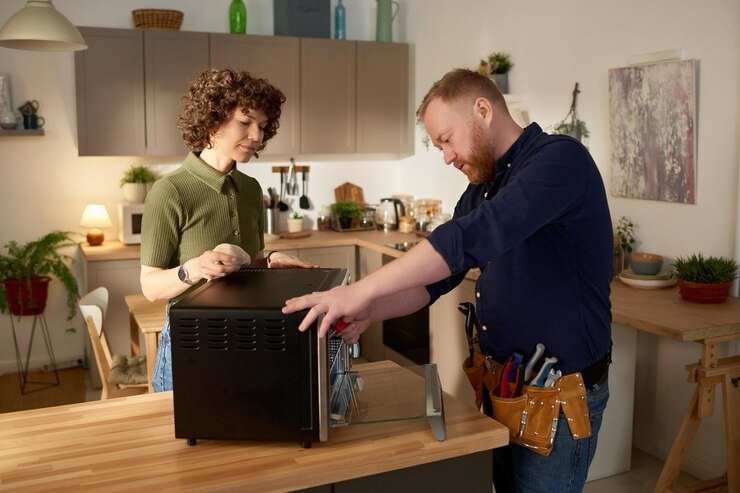Staring at a broken home appliance and wondering if you should fix it or buy a new one? This choice comes down to several key factors: age and lifespan, repair costs versus replacement price, energy efficiency upgrades, appliance type, and professional help availability.
Bottom Line: Appliances more than 10 years old or with repairs costing more than 50% of a replacement typically aren’t worth repairing. This repair versus replacement decision affects your budget and your home’s efficiency.
You face this question with every malfunctioning fridge, washing machine, or dishwasher. With living costs rising, you want to extend appliance life and avoid unnecessary purchases. Yet you need to assess whether fixes make sense or replacement offers better long-term value.
Repair vs. Replace Home Appliances decisions depend on multiple factors: appliance age, repair costs, replacement prices, efficiency upgrades, appliance type, parts availability, service options, warranties, and your DIY skills. Weighing these factors guides you to the smartest choice for your situation and budget.
Age and Lifespan: The Foundation of Your Decision
Your appliance’s current age and remaining life expectancy determine much of your repair-replace strategy.
Check Your Appliance’s Age
Check original receipts or warranty documents for exact age. Without paperwork, look up the model to find the production year. Today, you can expect an average lifespan for a washer of 10 years, while the typical dryer will last 13 years. Dishwashers are expected to last 9 years, and refrigerators have an expected lifespan of 13 years.
Compare the current age with the expected lifespan for that appliance type. Even if refrigerators are constantly running 24 hours a day, you can expect them to last an average of 13 to 15 years. Washing machines typically last 7-12 years, while dishwashers average 9-13 years.
Check if other parts show wear. Multiple recent repairs signal that replacement time is approaching.
Match Remaining Years with Repair Costs
If your appliance exceeds average lifespan, repairs may provide only temporary fixes. Replacement becomes more attractive.
New appliances deserve fixing, especially when repair costs stay minimal compared to buying new.
Calculate years of use remaining after repairs. Upgrading may not make sense if you can get 5+ years from a fixed older appliance.
Appliance Categories and Their Repair Feasibility
Kitchen appliances like refrigerators and dishwashers have longer lifespans, making repairs sensible even at 15 years old.
Laundry machines face more wear and higher repair costs. Replacement may be better than repairs beyond 6-8 years.
Small countertop appliances like mixers and toasters cost little to repair compared to replacement. Fix them even when old.
Heating and cooling systems need replacement consideration after 10-15 years.
Cost Analysis: The 50% Rule
Most appliance repairs cost between $108 and $250, depending on the level of damage and price of replacement parts. Simple math guides your repair or replacement choice.
Calculate True Repair Costs
Get detailed estimates from appliance repair technicians for parts, service, and labor. Appliance repair labor costs $50 to $125 per hour. Factor in additional repairs your appliance’s age might require.
Consider recent repair frequency. Multiple fixes in one year justify replacement.
For DIY repairs, include parts, tools, time, and effort costs.
Research New Appliance Prices
Find current prices for similar replacement appliances with comparable features. The cost of a new home appliance is $250 to $1,300 on average.
High-end brands may cost too much. Consider quality alternatives at lower prices.
Sales events and seasonal deals cut replacement costs significantly. Shop strategically.
Calculate costs over the appliance’s lifespan. Pricier but durable appliances may save money long-term.
Apply the 50% Rule
If the repair cost is 50% or less than the cost of replacing it with a new appliance, then the repair is worthwhile. If it is over 50%, then it is time to replace it with a new one.
Minor repair costs extend appliance life. Consider urgency – you can wait for sales before replacing working, repaired appliances.
Energy Efficiency and Environmental Impact
Neglecting maintenance shortens lifespan and causes early failures. Upgrading older appliances provides energy savings.
Preventive Maintenance Effects
Lack of maintenance, like cleaning or part replacements, causes avoidable breakdowns. Investing in recommended maintenance improves efficiency and lifespan. Well-maintained appliances may have significant years left, making repairs worthwhile.
Energy-Efficient Models and Savings
Repairing very old appliances may not make sense due to poor energy efficiency. ENERGY STAR-certified refrigerators are about 9 percent more energy efficient than models that meet the federal minimum energy efficiency standard.
By properly recycling your old refrigerator and replacing it with a new ENERGY STAR-certified refrigerator, you can save about $150 over the 12-year lifetime of the product.
Upgrade to high-efficiency models to offset higher purchase costs through lower utility bills.
Sustainability and Cost Benefits
Replacing outdated appliances positively impacts the environment through energy savings. Reduced energy consumption saves money and conserves natural resources. Take advantage of rebates, tax credits, and incentives for upgrading to energy-efficient models.
Appliance-Specific Repair Considerations
Repair versus replacement evaluation depends on your specific appliance type and unique factors.
Major Appliance Components and Common Issues
Refrigerators deserve repair investment as heavily used appliances. Refrigerator repair costs between $150 and $600, depending on the issue. Look for clogged drain lines, fan motor issues, defective thermostats, or control boards.
Dishwashers have few moving parts and a fairly simple operation. Dishwasher repair costs usually range from $100 to $400. Many dishwasher repairs work as DIY projects. Check for clogs, drain pump failure, or control board issues.
Washers and Dryers serve essential cleaning functions, making repairs worth considering. Washing machine repairs can cost between $150 and $350 to fix, depending on the problem. Focus on bearings, pulleys, and lid switch issues for washers. Dryer repairs target belts, rollers, and heating elements.
Ovens and Ranges make range repairs like replacing igniters or control boards, reasonable. Repairs for ovens or stoves generally range from $100 to $600. Built-in ovens make replacement labor-intensive and expensive.
HVAC Systems need specialized technicians for refrigerant leaks, electrical components, and blowers. Some homeowners replace entire systems.
Parts Availability for Repairs
Research accessibility and the cost of replacement parts, especially for older or discontinued models. Appliances with readily available parts make good repair candidates.
If parts become obsolete, repair may not work, and replacement makes sense.
Long-Term Thinking
Prioritize repairs for appliances vital to daily life, like refrigerators or laundry equipment. Minor kitchen or outdoor appliances may not deserve expensive repairs when you can live without them or replace them cheaply.
Decide whether to invest repair money in an old appliance or put it toward a new one.
Professional vs DIY Repair Services
Professional repairs and DIY fixes both offer viable options with unique pros, cons, and costs.
Appliance Repair Specialists
Experienced technicians properly diagnose issues and have expertise in complex repairs. Professional repairs work best for electrical appliances, built-in ovens, and high-cost appliances.
An appliance repair service call costs $70 to $130 for diagnostics and 1 hour of labor. Ask about service call fees, hourly rates, parts costs, and warranties to determine total charges.
DIY Repair Considerations
Common appliance issues like broken control boards, motors, or valves can work as DIY projects. DIY repairs need mechanical skills, proper tools, and research to correctly diagnose issues.
Consider whether investing your time and effort makes sense to fix an old appliance.
Safety and Warranty Factors
Repairs on gas lines, electrical components, and refrigerant systems belong to professionals. DIY repairs may void manufacturer warranties – check warranty terms.
Incorrect repairs cause more damage. Use caution with DIY routes for complex repairs.
Making Your Final Decision
Choosing whether to repair or replace home appliances requires careful analysis, but it can save money if done right. Key factors include appliance age and expected lifespan, cost comparisons between repairs and replacement options, energy efficiency impacts, appliance type considerations, professional help availability or DIY feasibility, and manufacturer warranty limitations.
Looking at these factors objectively provides clarity on whether appliance repair investment makes sense or replacement offers better long-term value. For expensive, frequently used appliances like refrigerators and laundry machines, repairs may make economic sense for added service years. Smaller appliances may reach points where replacement beats complex repairs.
Household appliance decisions require balancing your specific needs and budget. Seek professional consultations, get repair estimates in writing, research new appliance options, and don’t underestimate your DIY capabilities. With the right approach, you can make informed appliance repair or replacement decisions that save time, money, and hassle.




No Comment! Be the first one.